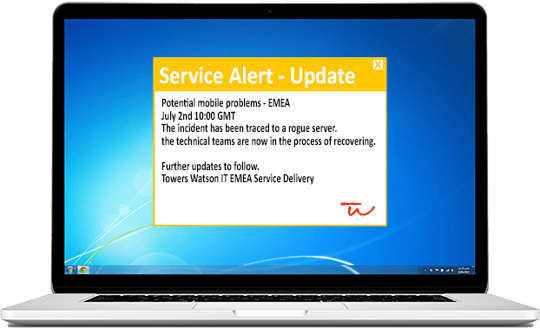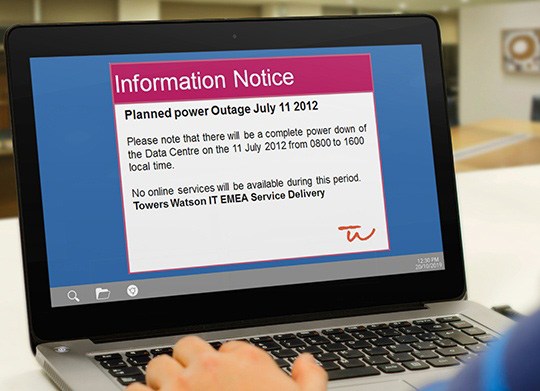IT Outage Notifications Set High Standards At Towers Watson

Our Customer
Towers Watson
Their Industry
Professional services
Location
United Kingdom
Number of Employees
5,000 staff and 15,000 associates across 16 countries
Background
Key Challenges
The organizational structure at Tower Watson presented Fernández with a number of challenges. The 5,000 staff and 15,000 associates worldwide were distributed across 16 countries, speaking multiple languages.
Effectively communicating with all staff given this structure was naturally difficult. Fernández needed to improve IT outage communication and reduce the number of calls to the service desk. He was also keen to gauge message success by tracking how many employees have seen the messages.
Solution
Towers Watson have been using SnapComms Desktop Alerts since August 2012 as a mechanism for updating staff about high-priority IT outages and notifications.
Desktop alerts are ideally-suited to this, being designed for high impact to get employee attention immediately, whatever screens or devices employees use – desktop, mobile or digital signage.
Tools Implemented
Application
The IT team at Towers Watson has developed a set of branded IT outage notification templates for their desktop alerts, based on a simple traffic light system. Three of the templates are used for incident management — a new notification has a red theme, an update is gold and the closure of that issue is green. The fourth template is plum and is used to communicate upcoming work which might result in service interruption.
While Fernández says that “what we do is common sense,” there is a culture within the team of setting high standards. They use simple, jargon-free communications in English rather than trying to translate more technical information into local languages.

This focus on simplicity, quality and consistency has made desktop alerts highly effective in conveying the status of system outages to Towers Watson staff and third-party IT service providers in multiple locations and different time zones.
Fernández says that the use of clearly-defined templates has provided a “reasonable level of protocol.” But he also explains that Towers Watson is just scratching the surface in the way it is utilizing SnapComms, given the capabilities of the software.
While they could use it for other internal communications, they choose not to, and have restricted management of the tool to 12-15 administrators globally.

